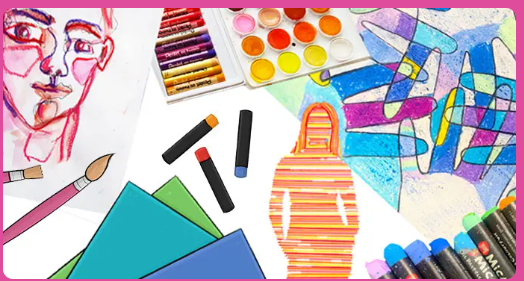In today’s dynamic educational landscape, the role of art education has become more significant than ever. Art is not merely a subject; it is a vital component that contributes to the holistic development of students. As educators, our goal is to design and deliver art lessons that not only teach artistic skills but also encourage creativity, critical thinking, and emotional intelligence. This comprehensive guide will provide you with innovative strategies and practical tips to create an engaging and impactful art lesson for teachers.
The Vital Role of Art Education in Schools
Art education nurtures a range of essential skills and competencies in students. It enhances their ability to think critically, solve problems creatively, and express themselves effectively. Research has shown that students engaged in regular art activities demonstrate improved academic performance, better social interactions, and increased self-confidence. Recognizing these benefits, it is crucial for teachers to integrate high-quality art lessons into the curriculum.
Creating a Dynamic Art Lesson Plan
An effective art lesson plan is the cornerstone of a successful classroom experience. Here’s a step-by-step guide to designing a dynamic art lesson plan:
1. Establish Clear Learning Objectives
Begin by identifying clear and specific learning objectives. What do you want your students to achieve by the end of the lesson? Objectives should be SMART (Specific, Measurable, Achievable, Relevant, and Time-bound). For example, “Students will be able to identify and use complementary colors to create a balanced composition.”
2. Prepare Essential Materials
Ensure that all necessary materials are prepared in advance. This includes not only basic supplies like paper, pencils, and paints but also any special tools or resources required for the lesson. Having everything ready helps maintain a smooth and uninterrupted workflow.
3. Incorporate Varied Activities
Diversify your activities to cater to different learning styles and keep students engaged. Include a mix of individual tasks, group projects, hands-on activities, and multimedia presentations. For instance, a lesson on abstract art could start with a brief introduction to famous abstract artists, followed by a hands-on activity where students create their own abstract pieces.
4. Provide Clear Instructions and Demonstrations
Break down the project into clear, manageable steps. Provide detailed instructions and, where possible, demonstrate each step. Visual aids, such as step-by-step guides or examples of finished work, can greatly enhance understanding.
Engaging and Motivating Students in Art Lessons
Keeping students engaged and motivated is key to a successful art lesson. Here are some strategies to enhance student engagement:
1. Connect Art to Real-Life Experiences
Make the lesson relevant by connecting art projects to students’ lives and experiences. Encourage them to create art that reflects their personal stories, communities, or cultural backgrounds. This relevance can make the lesson more meaningful and engaging.
2. Encourage Creative Freedom
Allow students the freedom to explore and express their creativity. While guidelines are necessary, providing room for individual expression can lead to more innovative and personal artwork. Encourage experimentation with different techniques and materials.
3. Use Interactive and Collaborative Techniques
Interactive and collaborative projects can significantly boost engagement. Group projects, peer reviews, and collaborative murals can foster a sense of community and collective creativity. These activities also help students develop teamwork and communication skills.
4. Offer Positive Reinforcement
Positive feedback is crucial in building confidence and encouraging further effort. Highlight each student’s strengths and provide constructive suggestions for improvement. Celebrate their achievements, no matter how small, to foster a positive learning environment.
Incorporating Technology in Art Education
Leveraging technology can greatly enhance the art education experience. Here are some ways to integrate technology into your art lessons:
1. Digital Art Software
Introduce students to digital art tools such as Adobe Photoshop, Illustrator, or free alternatives like Krita and GIMP. These tools can expand their creative capabilities and introduce them to the world of digital media.
2. Virtual Museum Tours and Online Galleries
Utilize virtual museum tours and online art galleries to expose students to a wide range of artworks and artistic styles. These resources provide access to renowned artworks and cultural heritage from around the world, enriching the students’ learning experience.
3. Online Tutorials and Educational Resources
Incorporate online tutorials and educational resources into your lessons. Platforms like YouTube, Khan Academy, and art-specific websites offer a plethora of instructional videos and interactive content that can supplement classroom teaching.
4. Interactive Devices and Software
Use interactive devices like tablets and interactive whiteboards to make lessons more dynamic. These tools can be used for drawing, presenting multimedia content, and facilitating collaborative projects, making the learning process more engaging and interactive.
Evaluating Student Progress in Art Education
Effective assessment in art education should consider both the creative process and the final product. Here are some strategies for evaluating student progress:
1. Portfolio Development
Encourage students to develop a portfolio of their work. This portfolio should include sketches, completed projects, and reflective writing. Portfolios provide a comprehensive overview of their artistic growth and progress over time.
2. Self-Assessment and Reflection
Incorporate self-assessment and reflection into the curriculum. Encourage students to evaluate their own work and reflect on their learning experiences. This practice helps them develop critical thinking and self-awareness.
3. Peer Assessment and Feedback
Implement peer assessment to provide students with diverse perspectives on their work. Peer feedback sessions can be valuable learning experiences, helping students understand different viewpoints and improve their own work.
4. Use of Rubrics
Develop rubrics that outline clear criteria for assessment. Rubrics should cover various aspects of the project, such as creativity, technique, effort, and presentation. They provide a structured and objective way to evaluate student work.
Conclusion
Crafting an effective and engaging art lesson for teachers requires careful planning, creativity, and a deep understanding of student needs. By establishing clear objectives, using diverse activities, incorporating technology, and providing constructive feedback, teachers can inspire their students and foster a lifelong love for art. Remember, the ultimate goal is to nurture creativity, critical thinking, and self-expression, empowering students to see the world through an artistic lens.




